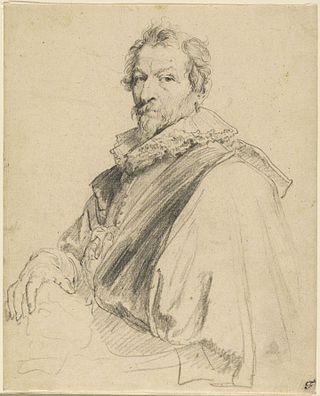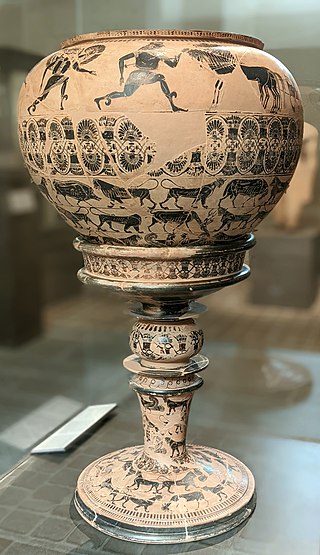
Édouard Manet was a French modernist painter. He was one of the first 19th-century artists to paint modern life, as well as a pivotal figure in the transition from Realism to Impressionism.

The Chimera or Chimaera (Chimæra), according to Greek mythology, was a monstrous fire-breathing hybrid creature, composed of different animal parts from Lycia, Asia Minor. It is usually depicted as a lion, with the head of a goat protruding from its back, and a tail that might end with a snake's head. It was an offspring of Typhon and Echidna and a sibling of monsters like Cerberus and the Lernaean Hydra.

Jean-Léon Gérôme was a French painter and sculptor in the style now known as academicism. His paintings were so widely reproduced that he was "arguably the world's most famous living artist by 1880." The range of his oeuvre included historical painting, Greek mythology, Orientalism, portraits, and other subjects, bringing the academic painting tradition to an artistic climax. He is considered one of the most important painters from this academic period. He was also a teacher with a long list of students.

Pottery, due to its relative durability, comprises a large part of the archaeological record of ancient Greece, and since there is so much of it, it has exerted a disproportionately large influence on our understanding of Greek society. The shards of pots discarded or buried in the 1st millennium BC are still the best guide available to understand the customary life and mind of the ancient Greeks. There were several vessels produced locally for everyday and kitchen use, yet finer pottery from regions such as Attica was imported by other civilizations throughout the Mediterranean, such as the Etruscans in Italy. There were a multitude of specific regional varieties, such as the South Italian ancient Greek pottery.

Black-figure pottery painting, also known as the black-figure style or black-figure ceramic, is one of the styles of painting on antique Greek vases. It was especially common between the 7th and 5th centuries BCE, although there are specimens dating as late as the 2nd century BCE. Stylistically it can be distinguished from the preceding orientalizing period and the subsequent red-figure pottery style.

Achille Jacques-Jean-Marie Devéria was a French painter and lithographer known for his portraits of famous writers and artists. His younger brother was the Romantic painter Eugène Devéria, and two of his six children were Théodule Devéria and Gabriel Devéria.
Oltos was a Late Archaic Greek vase painter, active in Athens from 525 BC to 500 BC. About 150 works by him are known. Two pieces, a cup in Berlin and a cup in Tarquinia, are signed by him as painter.

Joseph, Baron Ducreux was a French noble, portrait painter, pastelist, miniaturist, and engraver, who was a successful portraitist at the court of Louis XVI of France, and resumed his career at the conclusion of the French Revolution. He was made a baron and premier peintre de la reine, and drew the last portrait ever made of Louis XVI before the king's execution. His less formal portraits reflect his fascination with physiognomy and show an interest in expanding the range of facial expressions beyond those of conventional portraiture.

The Chimera of Arezzo is regarded as the best example of ancient Etruscan art. The British art historian David Ekserdjian described the sculpture as "one of the most arresting of all animal sculptures and the supreme masterpiece of Etruscan bronze-casting". Made entirely of bronze and measuring 78.5 cm high with a length of 129 cm, it was found alongside a small collection of other bronze statues in Arezzo, an ancient Etruscan and Roman city in Tuscany. The statue was originally part of a larger sculptural group representing a fight between a Chimera and the Greek hero Bellerophon. This sculpture is likely to have been created as a votive offering to the Etruscan god Tinia.

Hendrick van Balen or Hendrick van Balen I was a Flemish Baroque painter and stained glass designer. Hendrick van Balen specialised in small cabinet pictures often painted on a copper support. His favourite themes were mythological and allegorical scenes and, to a lesser extent, religious subjects. The artist played an important role in the renewal of Flemish painting in the early 17th century and was one of the teachers of Anthony van Dyck.

The Niobid Painter was an ancient Athenian vase painter in the red-figure style who was active from approximately 470 to 450 BC. He is named after a calyx krater which shows the god Apollo and his sister Artemis killing the children of Niobe, who were collectively called the Niobids. The krater is known as the Niobid Krater and is now housed at the Louvre in Paris. In his other work he shows a preference for Amazonomachy scenes and three-quarter-view faces. His student Polygnotos continued his style of vase painting.

The Nessos Painter, also known as Netos or Nettos Painter, was a pioneer of Attic black-figure vase painting. He is considered to be the first Athenian to adopt the Corinthian style who went on to develop his own style and introduced innovations. The Nessos Painter is often known to be one of the original painters of black-figure. He only worked in this style, which is shown on his name vase in the National Archaeological Museum in Athens. Most of the known Nessos Painter ceramics were found in funerary settings such as cemeteries and mortuaries.

James Sidney Edouard, Baron Ensor was a Belgian painter and printmaker, an important influence on expressionism and surrealism who lived in Ostend for most of his life. He was associated with the artistic group Les XX.

The Staatliche Antikensammlungen is a museum in Munich's Kunstareal holding Bavaria's collections of antiquities from Greece, Etruria and Rome, though the sculpture collection is located in the opposite Glyptothek and works created in Bavaria are on display in a separate museum. Ancient Egypt also has its own museum.

Etruscan art was produced by the Etruscan civilization in central Italy between the 10th and 1st centuries BC. From around 750 BC it was heavily influenced by Greek art, which was imported by the Etruscans, but always retained distinct characteristics. Particularly strong in this tradition were figurative sculpture in terracotta, wall-painting and metalworking especially in bronze. Jewellery and engraved gems of high quality were produced.

JohannesLingelbach (1622–1674) was a Dutch Golden Age painter, associated with the second generation of Bambocciate, a group of genre painters working in Rome from 1625–1700.

The Lysippides Painter was an Attic vase painter in the black-figure style. He was active around 530 to 510 BC. His conventional name comes from a kalos inscription on a vase in the British Museum attributed to him; his real name is not known.

The Underworld Painter was an ancient Greek Apulian vase painter whose works date to the second half of the 4th century BC.
The Lindtmayer family was a Swiss family of artists specialising in glass painting.

The Dinos of the Gorgon Painter is an important example of ancient Greek pottery, produced at Athens around 580 BC. It entered the Louvre's collection in 1861, with the purchase of Giampietro Campana's collection.


















